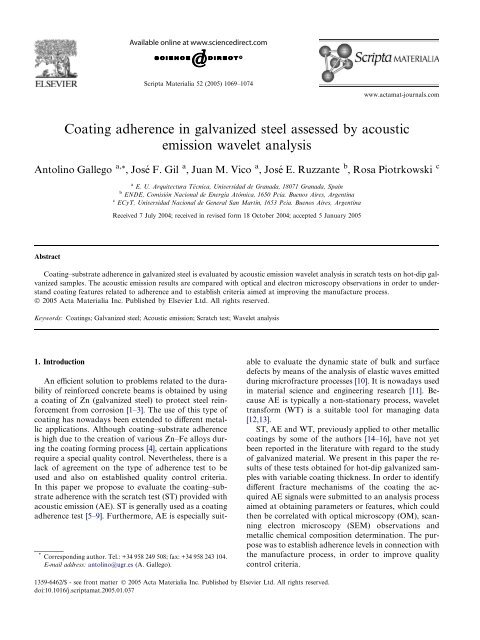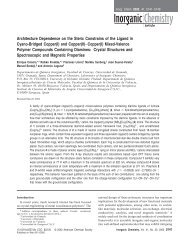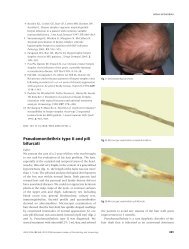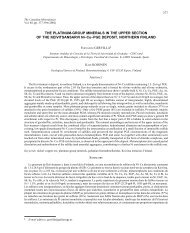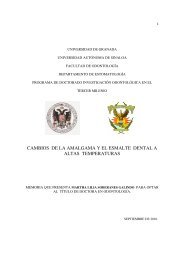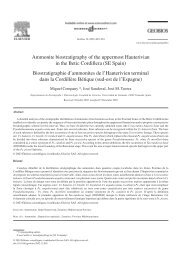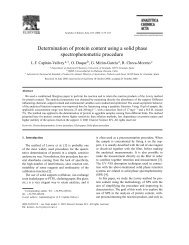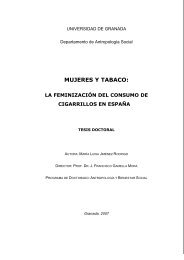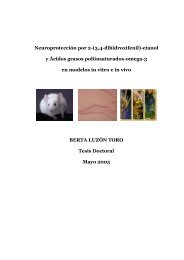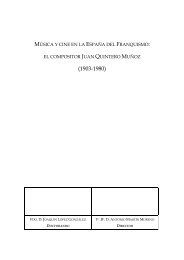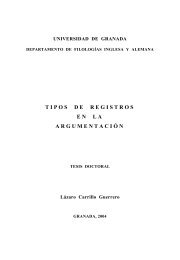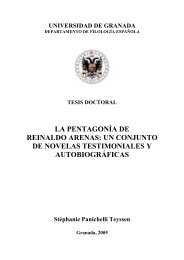Coating adherence in galvanized steel assessed by acoustic ...
Coating adherence in galvanized steel assessed by acoustic ...
Coating adherence in galvanized steel assessed by acoustic ...
You also want an ePaper? Increase the reach of your titles
YUMPU automatically turns print PDFs into web optimized ePapers that Google loves.
<strong>Coat<strong>in</strong>g</strong> <strong>adherence</strong> <strong>in</strong> <strong>galvanized</strong> <strong>steel</strong> <strong>assessed</strong> <strong>by</strong> <strong>acoustic</strong><br />
emission wavelet analysis<br />
Antol<strong>in</strong>o Gallego a, *, José F. Gil a , Juan M. Vico a , José E. Ruzzante b , Rosa Piotrkowski c<br />
Abstract<br />
a E. U. Arquitectura Técnica, Universidad de Granada, 18071 Granada, Spa<strong>in</strong><br />
b ENDE, Comisión Nacional de Energía Atómica, 1650 Pcia. Buenos Aires, Argent<strong>in</strong>a<br />
c ECyT, Universidad Nacional de General San Martín, 1653 Pcia. Buenos Aires, Argent<strong>in</strong>a<br />
Received 7 July 2004; received <strong>in</strong> revised form 18 October 2004; accepted 5 January 2005<br />
<strong>Coat<strong>in</strong>g</strong>–substrate <strong>adherence</strong> <strong>in</strong> <strong>galvanized</strong> <strong>steel</strong> is evaluated <strong>by</strong> <strong>acoustic</strong> emission wavelet analysis <strong>in</strong> scratch tests on hot-dip <strong>galvanized</strong><br />
samples. The <strong>acoustic</strong> emission results are compared with optical and electron microscopy observations <strong>in</strong> order to understand<br />
coat<strong>in</strong>g features related to <strong>adherence</strong> and to establish criteria aimed at improv<strong>in</strong>g the manufacture process.<br />
Ó 2005 Acta Materialia Inc. Published <strong>by</strong> Elsevier Ltd. All rights reserved.<br />
Keywords: <strong>Coat<strong>in</strong>g</strong>s; Galvanized <strong>steel</strong>; Acoustic emission; Scratch test; Wavelet analysis<br />
1. Introduction<br />
Scripta Materialia 52 (2005) 1069–1074<br />
An efficient solution to problems related to the durability<br />
of re<strong>in</strong>forced concrete beams is obta<strong>in</strong>ed <strong>by</strong> us<strong>in</strong>g<br />
a coat<strong>in</strong>g of Zn (<strong>galvanized</strong> <strong>steel</strong>) to protect <strong>steel</strong> re<strong>in</strong>forcement<br />
from corrosion [1–3]. The use of this type of<br />
coat<strong>in</strong>g has nowadays been extended to different metallic<br />
applications. Although coat<strong>in</strong>g–substrate <strong>adherence</strong><br />
is high due to the creation of various Zn–Fe alloys dur<strong>in</strong>g<br />
the coat<strong>in</strong>g form<strong>in</strong>g process [4], certa<strong>in</strong> applications<br />
require a special quality control. Nevertheless, there is a<br />
lack of agreement on the type of <strong>adherence</strong> test to be<br />
used and also on established quality control criteria.<br />
In this paper we propose to evaluate the coat<strong>in</strong>g–substrate<br />
<strong>adherence</strong> with the scratch test (ST) provided with<br />
<strong>acoustic</strong> emission (AE). ST is generally used as a coat<strong>in</strong>g<br />
<strong>adherence</strong> test [5–9]. Furthermore, AE is especially suit-<br />
* Correspond<strong>in</strong>g author. Tel.: +34 958 249 508; fax: +34 958 243 104.<br />
E-mail address: antol<strong>in</strong>o@ugr.es (A. Gallego).<br />
1359-6462/$ - see front matter Ó 2005 Acta Materialia Inc. Published <strong>by</strong> Elsevier Ltd. All rights reserved.<br />
doi:10.1016/j.scriptamat.2005.01.037<br />
www.actamat-journals.com<br />
able to evaluate the dynamic state of bulk and surface<br />
defects <strong>by</strong> means of the analysis of elastic waves emitted<br />
dur<strong>in</strong>g microfracture processes [10]. It is nowadays used<br />
<strong>in</strong> material science and eng<strong>in</strong>eer<strong>in</strong>g research [11]. Because<br />
AE is typically a non-stationary process, wavelet<br />
transform (WT) is a suitable tool for manag<strong>in</strong>g data<br />
[12,13].<br />
ST, AE and WT, previously applied to other metallic<br />
coat<strong>in</strong>gs <strong>by</strong> some of the authors [14–16], have not yet<br />
been reported <strong>in</strong> the literature with regard to the study<br />
of <strong>galvanized</strong> material. We present <strong>in</strong> this paper the results<br />
of these tests obta<strong>in</strong>ed for hot-dip <strong>galvanized</strong> samples<br />
with variable coat<strong>in</strong>g thickness. In order to identify<br />
different fracture mechanisms of the coat<strong>in</strong>g the acquired<br />
AE signals were submitted to an analysis process<br />
aimed at obta<strong>in</strong><strong>in</strong>g parameters or features, which could<br />
then be correlated with optical microscopy (OM), scann<strong>in</strong>g<br />
electron microscopy (SEM) observations and<br />
metallic chemical composition determ<strong>in</strong>ation. The purpose<br />
was to establish <strong>adherence</strong> levels <strong>in</strong> connection with<br />
the manufacture process, <strong>in</strong> order to improve quality<br />
control criteria.
1070 A. Gallego et al. / Scripta Materialia 52 (2005) 1069–1074<br />
2. Experimental<br />
2.1. Samples<br />
Steel plate samples were 50 mm · 20 mm · 4 mm.<br />
They were <strong>galvanized</strong> <strong>in</strong> a process that <strong>in</strong>cluded the follow<strong>in</strong>g<br />
consecutive stages: degreas<strong>in</strong>g bath at 80 °C,<br />
elim<strong>in</strong>ation of iron oxide <strong>by</strong> immersion <strong>in</strong> an aqueous<br />
solution of 15% hydrochloric acid at 35 °C, bath<br />
conta<strong>in</strong><strong>in</strong>g aqueous ammonium chloride at 80 °C,<br />
immersion <strong>in</strong> a Zn bath at 450 °C and air cool<strong>in</strong>g. Samples<br />
were then exam<strong>in</strong>ed visually and the thickness of<br />
the coat<strong>in</strong>gs was assigned <strong>by</strong> the <strong>in</strong>duced currents<br />
method.<br />
Five batches of 20 samples each were obta<strong>in</strong>ed,<br />
accord<strong>in</strong>g to their average immersion time. The samples,<br />
hang<strong>in</strong>g on vertical wires, were slowly <strong>in</strong>troduced <strong>in</strong>to<br />
the Zn bath. Due to this procedure, the immersion time<br />
was then different for samples correspond<strong>in</strong>g to the<br />
same batch and also varied along each sample. For this<br />
reason the coat<strong>in</strong>g thickness of each sample was nonhomogeneous.<br />
The thickness assigned to each sample<br />
was the average of three values measured at different<br />
po<strong>in</strong>ts, with a dispersion of 20%. Moreover, average values<br />
were evaluated for each batch. Accord<strong>in</strong>g to these<br />
results samples were classified accord<strong>in</strong>g to coat<strong>in</strong>g<br />
thickness as high (H) 200–220 lm, medium (M) 140–<br />
150 lm and low (L) ffi 100 lm. Five samples of each<br />
type were selected for the present <strong>in</strong>vestigation. They<br />
were designated as Li, Mi, Hi (i =1...5).<br />
2.2. <strong>Coat<strong>in</strong>g</strong> characteristics<br />
Samples L5, M5 and H5 were cut transversally and<br />
prepared for the metallographic studies. <strong>Coat<strong>in</strong>g</strong>s were<br />
exam<strong>in</strong>ed <strong>by</strong> OM and SEM and the metallic composition<br />
was analyzed <strong>by</strong> energy dispersive X-ray (EDX)<br />
analysis. <strong>Coat<strong>in</strong>g</strong>s were non-homogeneous and the matrix–coat<strong>in</strong>g<br />
<strong>in</strong>terface boundary and the exterior surface<br />
were not flat at all. The different and well-known<br />
Zn–Fe phases [4] were observed from <strong>steel</strong> to z<strong>in</strong>c<br />
(see Fig. 1): gamma (a very th<strong>in</strong> and uniform layer<br />
along the coat<strong>in</strong>g), delta (very well def<strong>in</strong>ed), zeta (with<br />
columnar gra<strong>in</strong>s emerg<strong>in</strong>g from the delta/zeta <strong>in</strong>terface)<br />
and eta (almost pure Zn, present <strong>in</strong> a two phase region<br />
together with small dispersed zeta gra<strong>in</strong>s). Zeta and eta<br />
phases were <strong>in</strong>term<strong>in</strong>gled and their distribution showed<br />
a great variability along the coat<strong>in</strong>g. In some po<strong>in</strong>ts the<br />
zeta phase gra<strong>in</strong>s reached the exterior surface. These results<br />
were obta<strong>in</strong>ed <strong>by</strong> optical and EDX composition<br />
studies across coat<strong>in</strong>gs. Fig. 2 shows one of these<br />
results.<br />
2.3. Scratch tests<br />
Scratch tests were performed under controlled conditions<br />
with a device that consisted of a loaded probe with<br />
a diamond <strong>in</strong>denter mov<strong>in</strong>g l<strong>in</strong>early along the sample at<br />
constant speed and with l<strong>in</strong>early <strong>in</strong>creas<strong>in</strong>g force (0–<br />
150 N) for 180 s (Fig. 3). The steadily <strong>in</strong>creas<strong>in</strong>g contact<br />
load causes tensile stress beh<strong>in</strong>d the <strong>in</strong>denter tip (trail<strong>in</strong>g<br />
edge) and compressive stress ahead of the cutt<strong>in</strong>g tip<br />
(lead<strong>in</strong>g edge). The detection system used was MIS-<br />
TRAS 2001 from Physical Acoustics Corporation<br />
(PAC). The piezoelectric sensor, with frequency band<br />
100–1000 kHz, was attached with coupl<strong>in</strong>g wax on the<br />
topside of the samples. Then signals passed through<br />
pre-amplifiers (60 dB) and were measured <strong>by</strong> means of<br />
the AEDSP-32/16B card. The threshold was set at<br />
25 dB, and signals were digitized at 4 MHz/8 bits. In<br />
the present paper, the hit parameters analyzed were energy<br />
and cumulative energy throughout the test. ST<br />
with AE were performed on samples Li, Mi, Hi<br />
(i =1,..., 4).<br />
Fig. 1. Transverse optical micrographs show<strong>in</strong>g coat<strong>in</strong>g phases. Left: L-sample; Center: M-sample; Right: H-sample.
Fig. 2. L-Sample. Lower: Po<strong>in</strong>ts where EDX measurements were<br />
performed. Upper: Results. Fe contents: near 0%: eta phase; 1–9%:<br />
zeta phase; 9–17%: delta phase; 17–99% gamma phase; 100%: <strong>steel</strong>.<br />
Experimental error ± 0.01 at.%.<br />
Diamond tip<br />
Sensor<br />
Load Cell<br />
Sample<br />
Load<br />
3. Results and discussion<br />
Scratch<br />
Fig. 3. Experimental setup.<br />
3.1. Optical and electron microscopy<br />
Three scratches of approximately 1.1 cm were performed<br />
on each sample. OM images with high magnification<br />
were obta<strong>in</strong>ed along scratches on samples H1, M1<br />
A. Gallego et al. / Scripta Materialia 52 (2005) 1069–1074 1071<br />
AE Equipment<br />
and L 1, and were composed as a unique image with standard<br />
software. Scratches were also observed <strong>by</strong> SEM<br />
and the metallic chemical composition along each<br />
scratch was <strong>assessed</strong> with EDX, tak<strong>in</strong>g <strong>in</strong>to account that<br />
the penetration depth <strong>in</strong>creases with the <strong>in</strong>denter advance.<br />
Scratch l<strong>in</strong>es widened as penetration <strong>in</strong>creased.<br />
Moreover, scratches were not straight l<strong>in</strong>es; some deviation<br />
occurred, which was especially noticeable <strong>in</strong> H samples.<br />
This is due to the heterogeneity of the coat<strong>in</strong>g: the<br />
diamond tip had to go around the heterogeneous obstacles<br />
that could be zeta phase gra<strong>in</strong>s at the po<strong>in</strong>ts where<br />
they reached the surface. For the sake of brevity, we do<br />
not <strong>in</strong>clude the optical microscope composite image<br />
of scratches <strong>in</strong> the present paper.<br />
A number of t<strong>in</strong>y marks appeared at the beg<strong>in</strong>n<strong>in</strong>g of<br />
the scratches, correspond<strong>in</strong>g to plastic deformation of<br />
the coat<strong>in</strong>g; however, the relevant feature <strong>in</strong> all images<br />
(for all scratches and samples) was the presence of some<br />
apparent transverse cracks that were revealed upon further<br />
exam<strong>in</strong>ation to be folds. This has the important<br />
mean<strong>in</strong>g that the failure was <strong>in</strong>terfacial. As an example,<br />
<strong>in</strong> Fig. 4a and b we can see optical and scann<strong>in</strong>g electron<br />
microscope images of a fold. Noticeable folds appeared<br />
at roughly 50% and 70% of total scratch length <strong>in</strong> all<br />
cases.<br />
3.2. EDX determ<strong>in</strong>ation<br />
EDX and SEM were used to measure metallic chemical<br />
composition along the central l<strong>in</strong>e of scratches for<br />
each type of sample. In the first stages of scratch<strong>in</strong>g,<br />
the Fe% was low enough to <strong>in</strong>fer that only the eta phase<br />
was reached. From an <strong>in</strong>termediate stage, measurements<br />
suggest that the zeta phase was reached. This behavior<br />
holds up to the f<strong>in</strong>al stage, <strong>in</strong>dicat<strong>in</strong>g that the <strong>in</strong>denter<br />
never touched the matrix, or even the delta and gamma<br />
phases. Table 1 shows the results for one of the samples.<br />
The metallic composition was determ<strong>in</strong>ed at 21 successive<br />
po<strong>in</strong>ts along the center of a scratch. The nonuniformity<br />
of the measured values, which exceeds<br />
experimental errors, is consistent with the non-uniformity<br />
of eta and zeta phase distribution.<br />
3.3. Acoustic emission<br />
Fig. 5 shows the parameters energy and cumulative<br />
energy for scratches <strong>in</strong> the three types of sample. The<br />
noticeable steps <strong>in</strong> cumulative parameters and the peaks<br />
<strong>in</strong> energy, <strong>in</strong> graphs where the <strong>in</strong>dependent variable is<br />
the % of total scratch length, are very close to the position<br />
of the folds observed <strong>in</strong> micrographs.<br />
3.4. Acoustic emission processed <strong>by</strong> wavelet analysis<br />
AE is a non-stationary process, i.e. the power<br />
spectrum changes with time, where short and long-time
1072 A. Gallego et al. / Scripta Materialia 52 (2005) 1069–1074<br />
phenomena coexist. For this reason a scale-time procedure<br />
like WT is an ideal tool to manage data. WT presents<br />
advantages over alternative methods like the<br />
short time Fourier transform (STFT) because suitable<br />
temporal and frequency w<strong>in</strong>dows are simultaneously def<strong>in</strong>ed<br />
along the calculation. WT applied to AE signals<br />
enhances the sharpness of results, thus allow<strong>in</strong>g further<br />
conclusions.<br />
A wavelet w(t) is an oscillat<strong>in</strong>g function of short<br />
duration, temporarily localized around the center<br />
t = 1/2. Its spectrum j^ wðxÞj 2 concentrates <strong>in</strong> a bilateral<br />
band 0 < x1 6 jxj 6 x2. By means of dilatations and<br />
displacements this mother function generates a family<br />
of elemental functions or atoms, wjk(t) with localization<br />
<strong>in</strong> time-scale, vary<strong>in</strong>g <strong>in</strong> an <strong>in</strong>verse proportion. By properly<br />
choos<strong>in</strong>g the wavelet w(t), the generated family constitutes<br />
an orthonormal basis of the space of signals with<br />
f<strong>in</strong>ite energy. Thus, given a signal s(t), it is possible to<br />
represent it <strong>by</strong> the series [12,13]:<br />
sðtÞ ¼ X X<br />
where<br />
cjk ¼<br />
Fig. 4. Micrographs of folds. Sample H1, scratch 3. Left: Optical microscope image. Right: Scann<strong>in</strong>g electron microscope image.<br />
Table 1<br />
Metallic composition (<strong>in</strong> at.%) at po<strong>in</strong>ts of scratch 1, sample H1 Po<strong>in</strong>t 1 2 3 4 5 6 7 8 9 10 11<br />
Fe(%) 0.96 0.31 0.32 0.38 0.23 0.21 0.26 0.37 1.11 0.87 0.51<br />
Zn(%) 99.04 99.69 99.68 99.62 99.77 99.79 99.74 99.63 98.89 99.13 99.49<br />
Po<strong>in</strong>t 12 13 14 15 16 17 18 19 20 21<br />
Fe(%) 0.30 0.54 0.38 0.42 0.34 0.37 0.31 0.39 0.35 1.51<br />
Zn(%) 99.70 99.46 99.62 99.58 99.66 99.63 99.69 99.61 99.65 98.49<br />
Experimental error ± 0.01 at.%.<br />
j<br />
Z 1<br />
1<br />
k<br />
cjkw jkðtÞ<br />
sðtÞw jkðtÞdt<br />
These coefficients summarize without any redundancy<br />
the whole signal <strong>in</strong>formation. In addition, the energy<br />
relation holds:<br />
Z 1<br />
1<br />
jsðtÞj 2 dt ¼ X X<br />
j<br />
k<br />
jcjkj 2<br />
WT was applied to our signals <strong>in</strong> order to corroborate<br />
the results shown <strong>in</strong> Section 3.3. and, if possible, to enhance<br />
the time (or position along the scratch) location of<br />
changes <strong>in</strong> the AE energy related to the development of<br />
significant folds. WT with the Haar basis was employed<br />
<strong>in</strong> calculations for simplicity reasons [12]. When compared<br />
with other wavelets such as gaussian, symmlet<br />
or Daubechies, the results were essentially the same.<br />
Fig. 6 shows the energy-position-scale wavelet diagrams<br />
for the AE data displayed <strong>in</strong> Fig. 5. More <strong>in</strong>tense<br />
colors correspond to higher <strong>acoustic</strong> energy. Accord<strong>in</strong>g<br />
to our assumptions, go<strong>in</strong>g from lower to higher % position,<br />
the first spots correspond to plastic deformation<br />
and detachment of small zeta gra<strong>in</strong>s. Likewise, more <strong>in</strong>tense<br />
spots, located at def<strong>in</strong>ite % positions correspond to<br />
zeta/delta, delta/gamma or gamma/<strong>steel</strong> <strong>in</strong>terface separation.<br />
These <strong>in</strong>terface separations appear to be what<br />
produces the folds observed <strong>in</strong> the micrographs. WT results<br />
(Fig. 6) are more accurate than those obta<strong>in</strong>ed <strong>by</strong><br />
traditional AE signal process<strong>in</strong>g (Fig. 5). The highest<br />
values <strong>in</strong> AE energy (Fig. 6) corresponded quite well<br />
with fold positions. In spite of the fact that the <strong>in</strong>denter<br />
had not reached <strong>in</strong>terfaces, the stress field produced <strong>by</strong><br />
<strong>in</strong>creas<strong>in</strong>g the contact force could have been sufficient<br />
to <strong>in</strong>duce the breakaway of successive layers.<br />
It was observed that AE activity <strong>in</strong>creased when<br />
the coat<strong>in</strong>g thickness decreased <strong>in</strong> the studied range.
Energy (eu)<br />
Energy (eu)<br />
Energy (eu)<br />
1.1<br />
1.0<br />
0.9<br />
0.8<br />
0.7<br />
0.6<br />
0.5<br />
0.4<br />
0.3<br />
0.2<br />
0.1<br />
0.0<br />
0 5 10 15 20 25 30 35 40 45 50 55 60 65 70 75 80 85 90 95 100<br />
Relative Position (%)<br />
3.2<br />
3.0<br />
2.8<br />
2.6<br />
2.4<br />
2.2<br />
2.0<br />
1.8<br />
1.6<br />
1.4<br />
1.2<br />
1.0<br />
0.8<br />
0.6<br />
0.4<br />
0.2<br />
0.0<br />
0 5 10 15 20 25 30 35 40 45 50 55 60 65 70 75 80 85 90 95 100<br />
3.0<br />
2.8<br />
2.6<br />
2.4<br />
2.2<br />
2.0<br />
1.8<br />
1.6<br />
1.4<br />
1.2<br />
1.0<br />
0.8<br />
0.6<br />
0.4<br />
0.2<br />
0.0<br />
Relative Position (%) Relative Position (%)<br />
0 5 10 15 20 25 30 35 40 45 50 55 60 65 70 75 80 85 90 95 100<br />
Relative Position (%)<br />
A. Gallego et al. / Scripta Materialia 52 (2005) 1069–1074 1073<br />
Accumulated Energy (eu)<br />
Accumulated Energy (eu)<br />
Accumulated Energy (eu)<br />
5.0<br />
4.5<br />
4.0<br />
3.5<br />
3.0<br />
2.5<br />
2.0<br />
1.5<br />
1.0<br />
0.5<br />
0.0<br />
0 5 10 15 20 25 30 35 40 45 50 55 60 65 70 75 80 85 90 95 100<br />
18<br />
17<br />
16<br />
15<br />
14<br />
13<br />
12<br />
11<br />
10<br />
9<br />
8<br />
7<br />
6<br />
5<br />
4<br />
3<br />
2<br />
1<br />
0<br />
45<br />
40<br />
35<br />
30<br />
25<br />
20<br />
15<br />
10<br />
5<br />
Relative Position (%)<br />
0 5 10 15 20 25 30 35 40 45 50 55 60 65 70 75 80 85 90 95 100<br />
0<br />
0 5 10 15 20 25 30 35 40 45 50 55 60 65 70 75 80 85 90 95 100<br />
Relative Position (%)<br />
Fig. 5. Upper: sample H1, scratch 1. Middle: sample M1, scratch 3. Lower: sample L1, scratch 2. Left: <strong>acoustic</strong> energy. Right: accumulated <strong>acoustic</strong><br />
energy.<br />
Fig. 6. Energy-position-scale wavelet diagrams. Red: highest energy, blue: lowest energy. Same samples and scratches as <strong>in</strong> Fig. 5. Left: H-sample.<br />
Middle: M-sample. Right: L-sample. (For <strong>in</strong>terpretation of the references <strong>in</strong> color <strong>in</strong> this figure legend, the reader is referred to the web version of this<br />
article.)
1074 A. Gallego et al. / Scripta Materialia 52 (2005) 1069–1074<br />
Moreover the steps <strong>in</strong> cumulative energy, which corresponded<br />
to the development of significant folds, showed<br />
up at lower % positions along the scratch (i.e. at lower<br />
depths <strong>in</strong>side the coat<strong>in</strong>g) when the thickness was lower.<br />
Therefore, coat<strong>in</strong>g performance improved when go<strong>in</strong>g<br />
from lower to higher thickness <strong>in</strong> the studied range.<br />
The results of the present paper constitute a step forward<br />
<strong>in</strong> recommend<strong>in</strong>g the use of AE parameters as<br />
<strong>in</strong>dicators of coat<strong>in</strong>g failure, <strong>in</strong> on-l<strong>in</strong>e measurements,<br />
<strong>in</strong>stead of a posteriori microscopic determ<strong>in</strong>ations.<br />
4. Conclusions<br />
Acoustic emission proved to be a good technique for<br />
assess<strong>in</strong>g coat<strong>in</strong>g/matrix <strong>adherence</strong> of <strong>galvanized</strong> <strong>steel</strong>,<br />
as it did <strong>in</strong> previously studied coat<strong>in</strong>gs on metallic samples<br />
[14–16]. The coat<strong>in</strong>g breakdown could have occurred<br />
<strong>by</strong> <strong>adherence</strong> failure at phase <strong>in</strong>terfaces, but the<br />
matrix would have never been touched <strong>by</strong> the <strong>in</strong>denter<br />
<strong>in</strong> the range of forces applied <strong>in</strong> the present work (0–<br />
150 N). <strong>Coat<strong>in</strong>g</strong> performance improved with thickness<br />
<strong>in</strong> the range 100–200 lm. Future work will be related<br />
to the evaluation and comparison of hot-dip and electrolytically<br />
<strong>galvanized</strong> samples, with different coat<strong>in</strong>g<br />
thicknesses and different degrees of corrosion.<br />
Acknowledgments<br />
The authors are grateful to EUROTEGA S.A., Granada,<br />
Spa<strong>in</strong>, for the galvaniz<strong>in</strong>g process, and to Eng.<br />
J.L. Piqueras and PhD. J. Rodriguez (University of Granada)<br />
for <strong>in</strong>terest<strong>in</strong>g discussions.<br />
References<br />
[1] Reumont G, Vogt JB, Iost A, Foct J. Surf <strong>Coat<strong>in</strong>g</strong>s Technol<br />
2001;139:265.<br />
[2] Bautista A, González JA. Cement Conc Res 1996;26(2):215.<br />
[3] Treadway KWJ, Brown BL, Cox RN. Corrosion of re<strong>in</strong>forc<strong>in</strong>g<br />
<strong>steel</strong> <strong>in</strong> concrete. American Society of Test<strong>in</strong>g and Materials,<br />
ASTM STP 1980;713:102.<br />
[4] Raghavan V. J Phase Equilibria 2003;24(6):544.<br />
[5] Dalmas BD, Benmedakhene S, Richard C, Laksimi A, Bégenger<br />
G, Grégoire T. CR Acad Sci Paris, Chimie/Chemistry 2001;4:<br />
345.<br />
[6] Ollendorf H, Schneider D. Surf <strong>Coat<strong>in</strong>g</strong>s Technol 1999;113:86.<br />
[7] Garchon Y, Hénau C. Th<strong>in</strong> Solid Films 2000;377/378:360.<br />
[8] Ichimura H, Rodrigo A. Surf <strong>Coat<strong>in</strong>g</strong>s Technol 2000;126:152.<br />
[9] Wen F, Huang N, Sun H, Wan GJ, Chu PK, Leng Y. Nucl Instr<br />
Methods Phys Res 2004;222(1–2):81–90.<br />
[10] Heiple CR, Carpenter SH, Armentrout DL, Mc Manigle A.<br />
Mater Eval 1994;52:590.<br />
[11] Mittra J, Dubey JS, Banerjee S. Scripta Mater 2003;49:1209.<br />
[12] Meyer Y. Wavelets: Algorithms and applications. Philadelphia:<br />
SIAM; 1993.<br />
[13] Maradei C, Piotrkowski R, Serrano E, Ruzzante JE. Insight<br />
2002;44(12):786.<br />
[14] Piotrkowski R, Gallego A, Ruzzante JE, García-Hernández<br />
MT. J Nondestructive Test<strong>in</strong>g & Ultrason 2002. ISSN: 1435-<br />
4934.<br />
[15] Piotrkowski R, Gallego A, Ruzzante JE, García Hernández MT.<br />
In: Proceed<strong>in</strong>gs of 3rd Pan American Conference for Non-<br />
Destructive Test<strong>in</strong>g (PANNDT), Rio de Janeiro, Brazil, 2–7 June<br />
2003.<br />
[16] Piotrkowski R, Gallego A, Castro E, García-Hernández MT,<br />
Ruzzante JE. NDT and E Int 2005;38(4):260–7.


